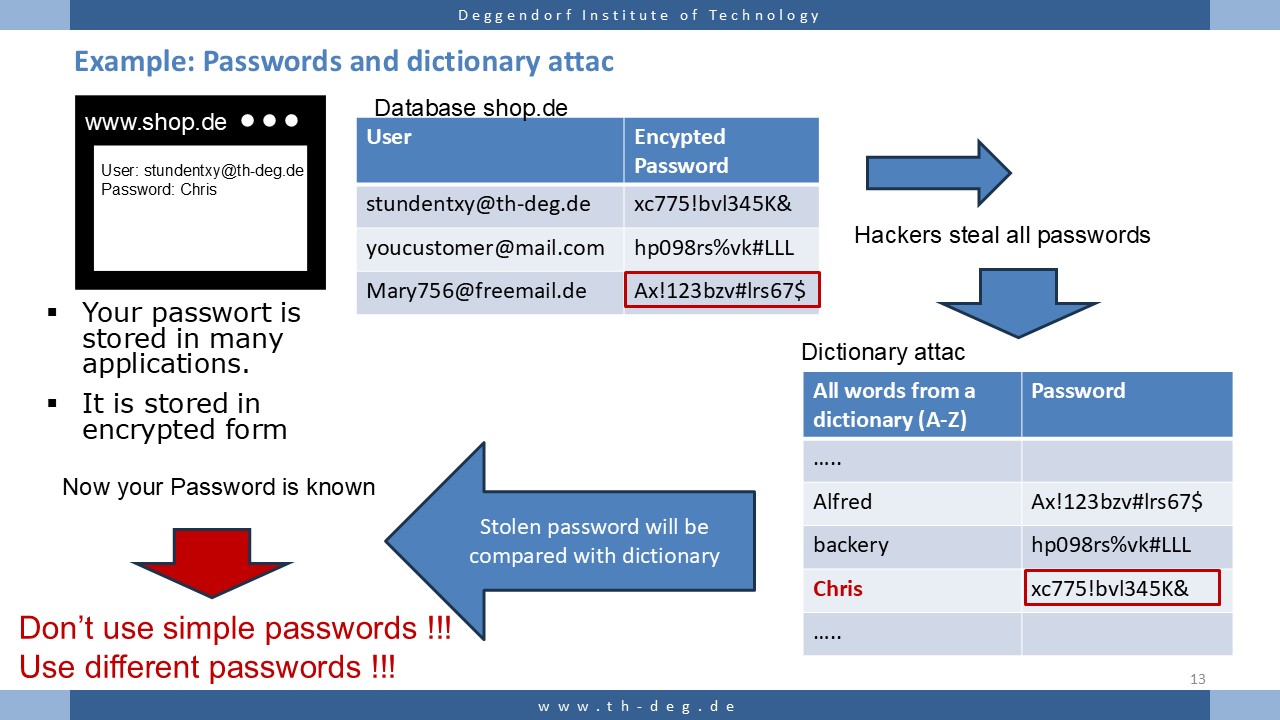Chapter 2 - Data and Data Processing
| Site: | iLearn - Lernmanagementsystem der Hochschule Deggendorf |
| Course: | vhb Demo: IT Fundamentals |
| Book: | Chapter 2 - Data and Data Processing |
| Printed by: | Gast |
| Date: | Thursday, 11 December 2025, 2:41 AM |
Chapter 2 Data and Data Processing Content
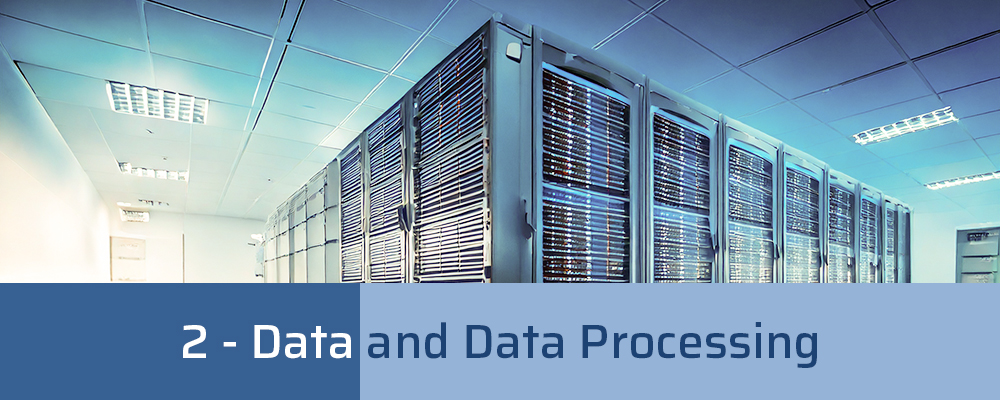
Overview
Learning Objectives
The students will ...
- get an overview about concepts of date, information and knowledge,
- understand data types and formats,
- be able to understand and describe file systems and databases and
- know how to process data.
<<< back to main page
continue to 2.1 >>>
Chapter 2 Part 1 Concepts of data, information and knowledge
Part 1: Concepts of data, information and knowledge
Structure of the knowledge pyramid
The concept of data
The term data refers to information or values that are available in a raw or processed form and serve as the basis for decisions, calculations or analyses. It can take the form of numbers, text, images, audio files or other formats and represents the building blocks of knowledge when placed in context.
Characteristics of data
- Neutrality: Data is initially neutral information without interpretation or context.
- Example: "25" is a data value that has no meaning without context.
- Formats: Data can be available in various forms, e.g. as numbers, letters, symbols, images, videos or sounds.
- Use: Data is the basis for analyses, calculations, reports and decisions.
- Storage: Data can be stored digitally (e.g. in databases, files) or analog (e.g. on paper).
- Data can be divided into different categories. These classifications help to better understand, organize and use data in a targeted manner.
Data classification
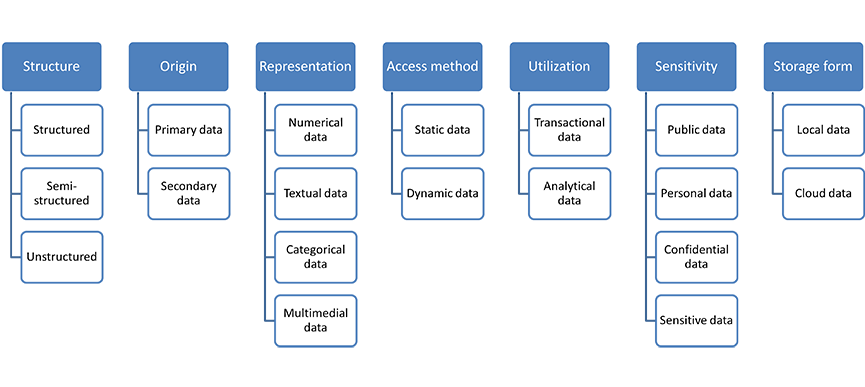
By structure
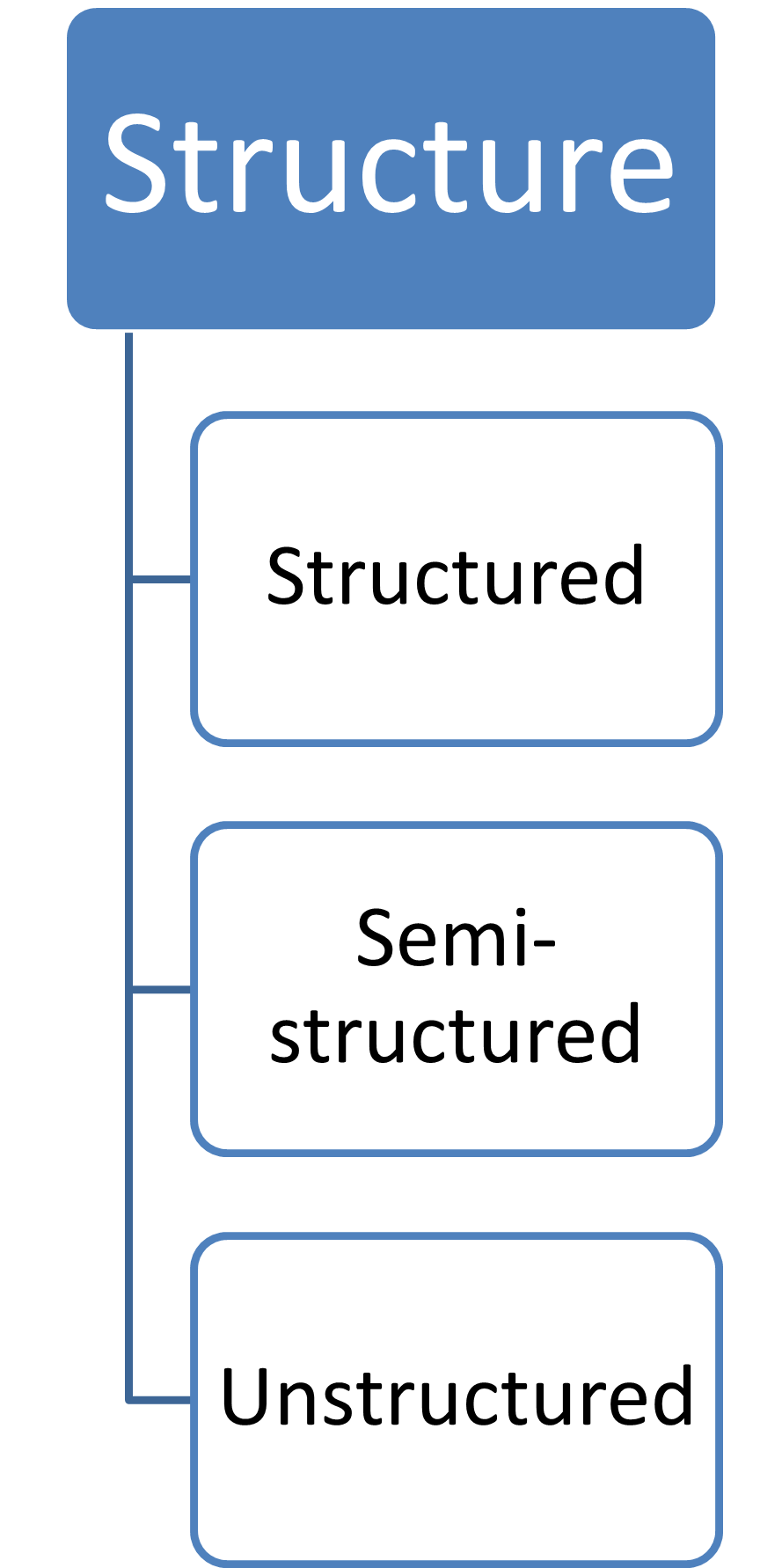 |
Structured data
Unstructured data
Semi-structured data
|
By origin
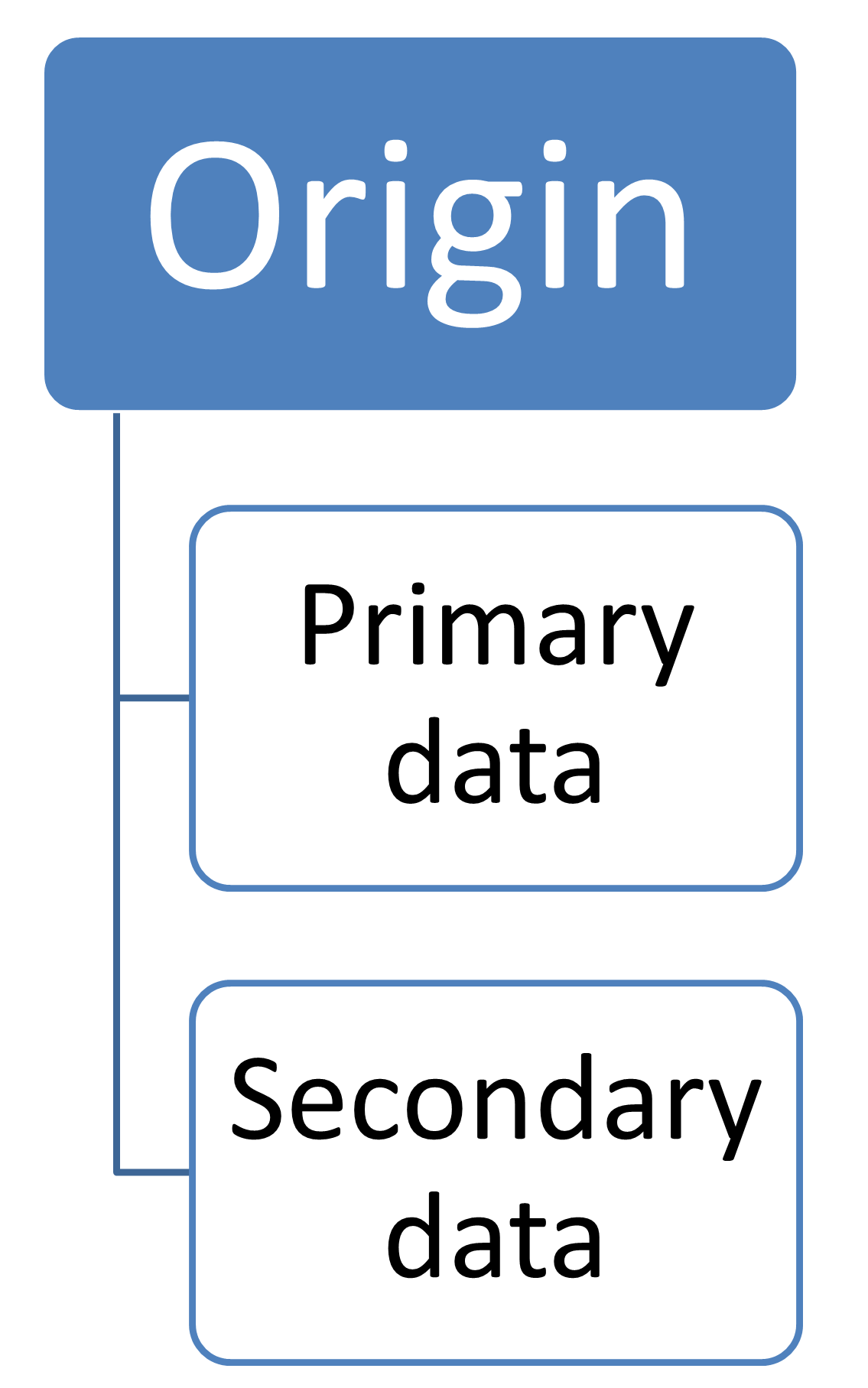 |
Primary data
Secondary data
|
By representation
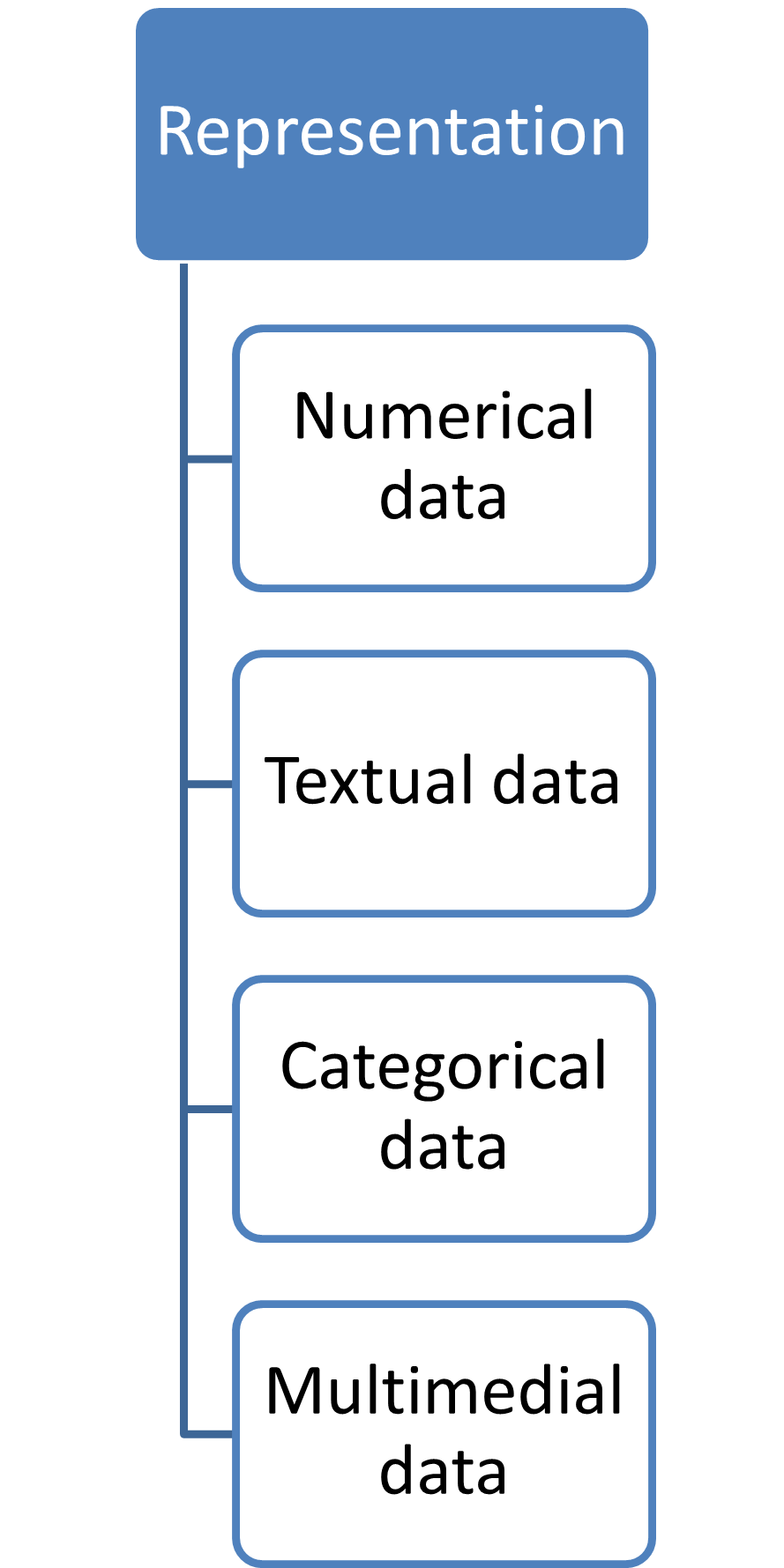 |
Numerical data
Categorical data
|
Textual data
Multimedia data
|
By access method
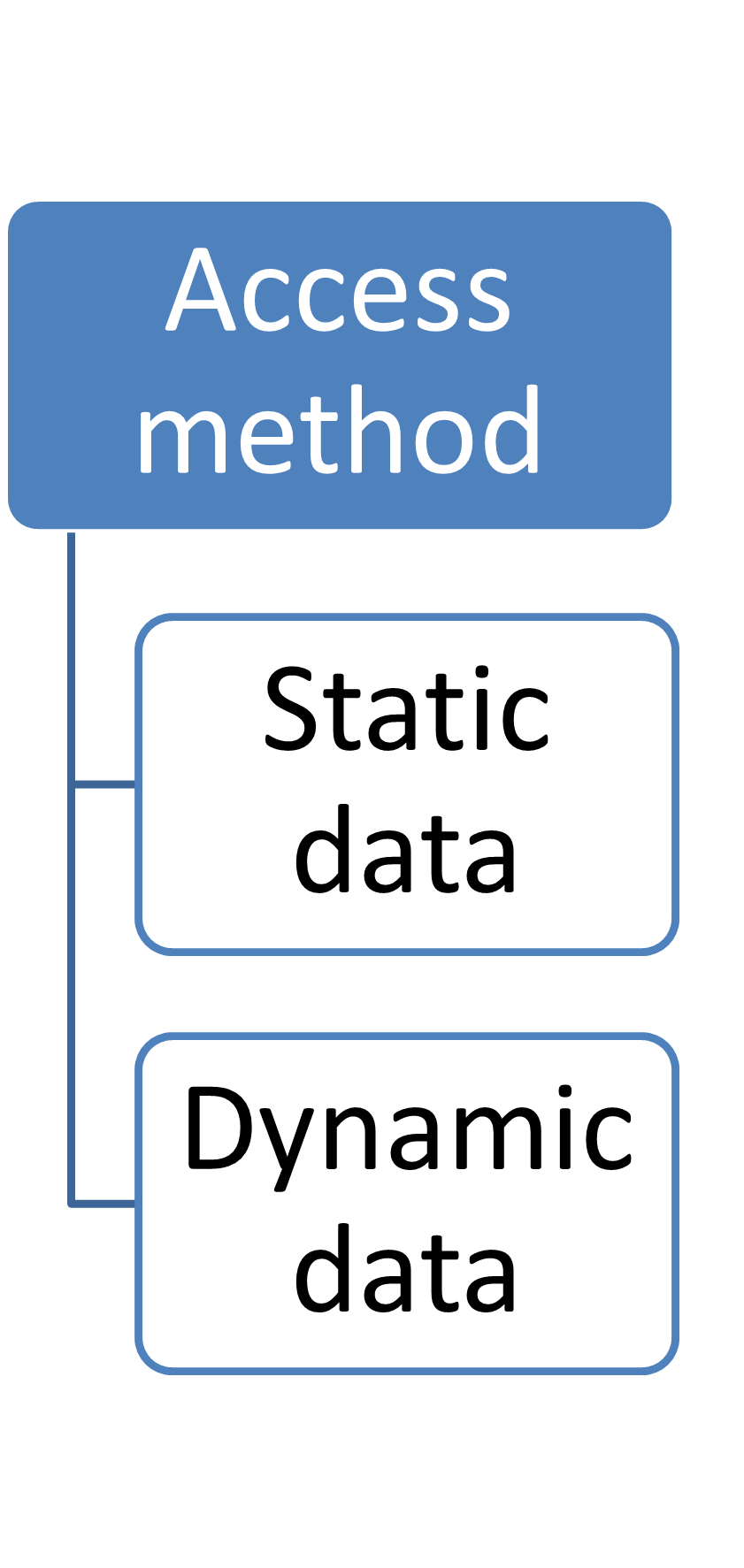 |
Static data
Dynamic data
|
After use
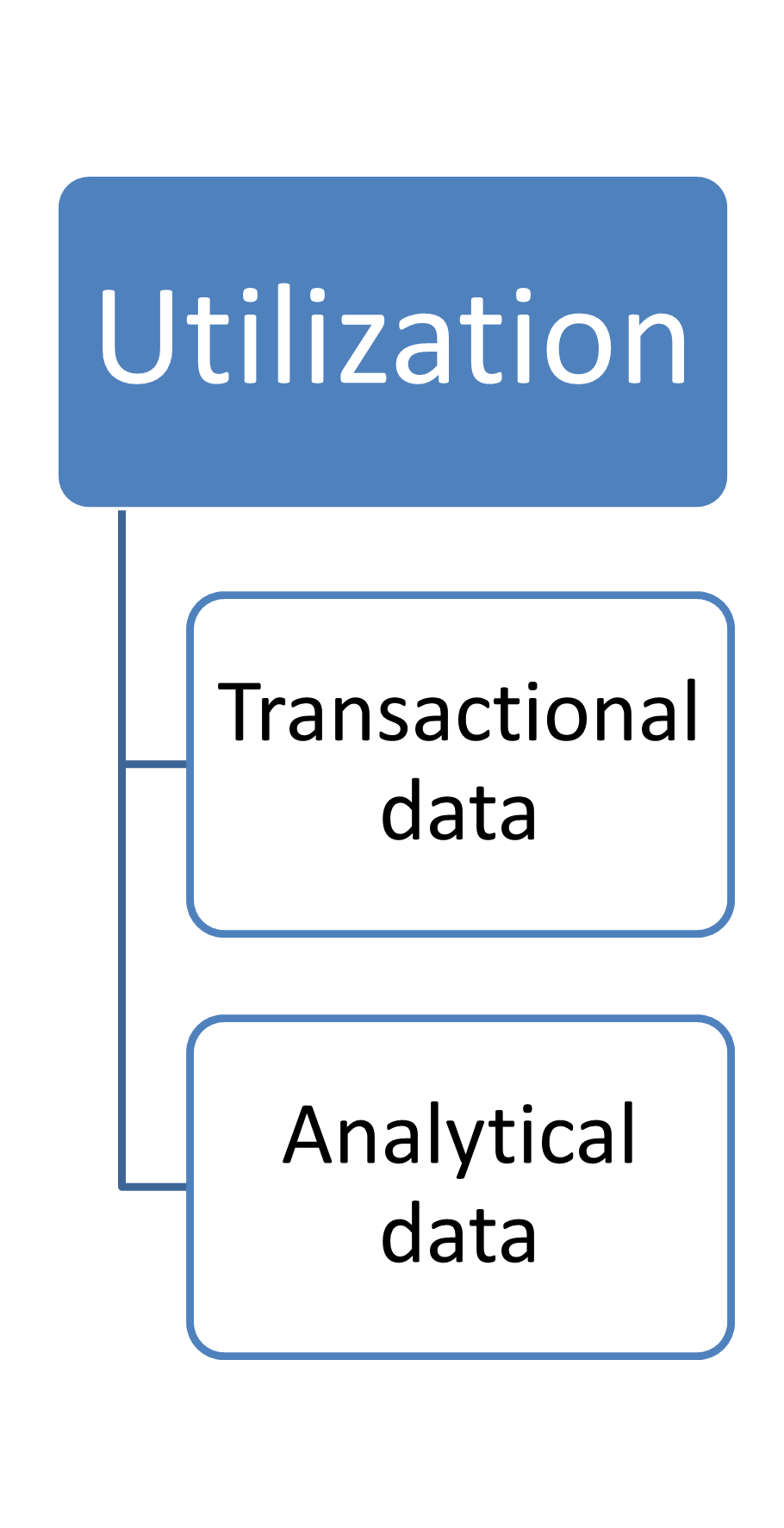 |
Transactional data
Analytical data
|
By sensitivity
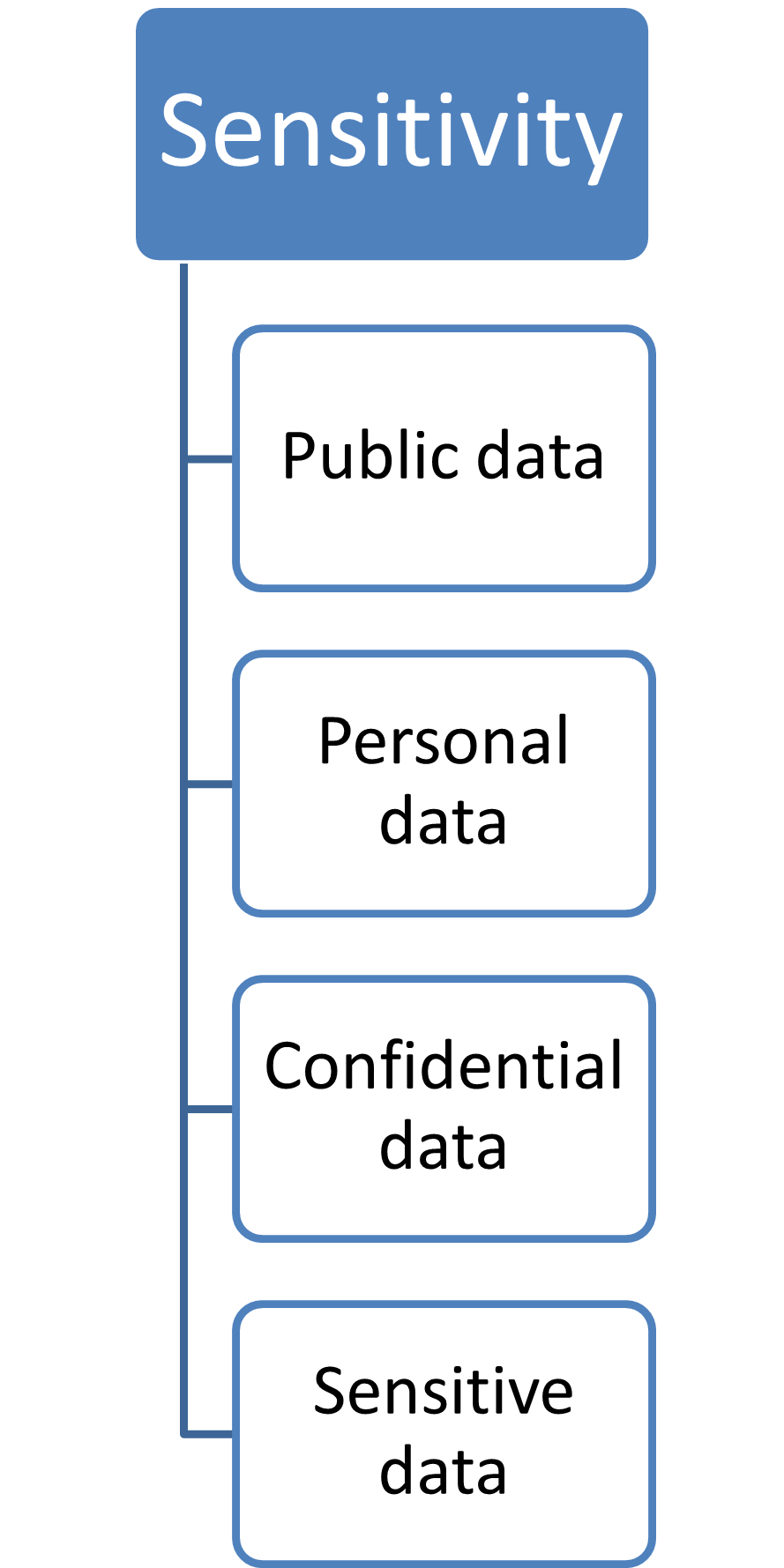 |
Public data
Confidential data
|
Personal data
Sensitive data
|
By storage form
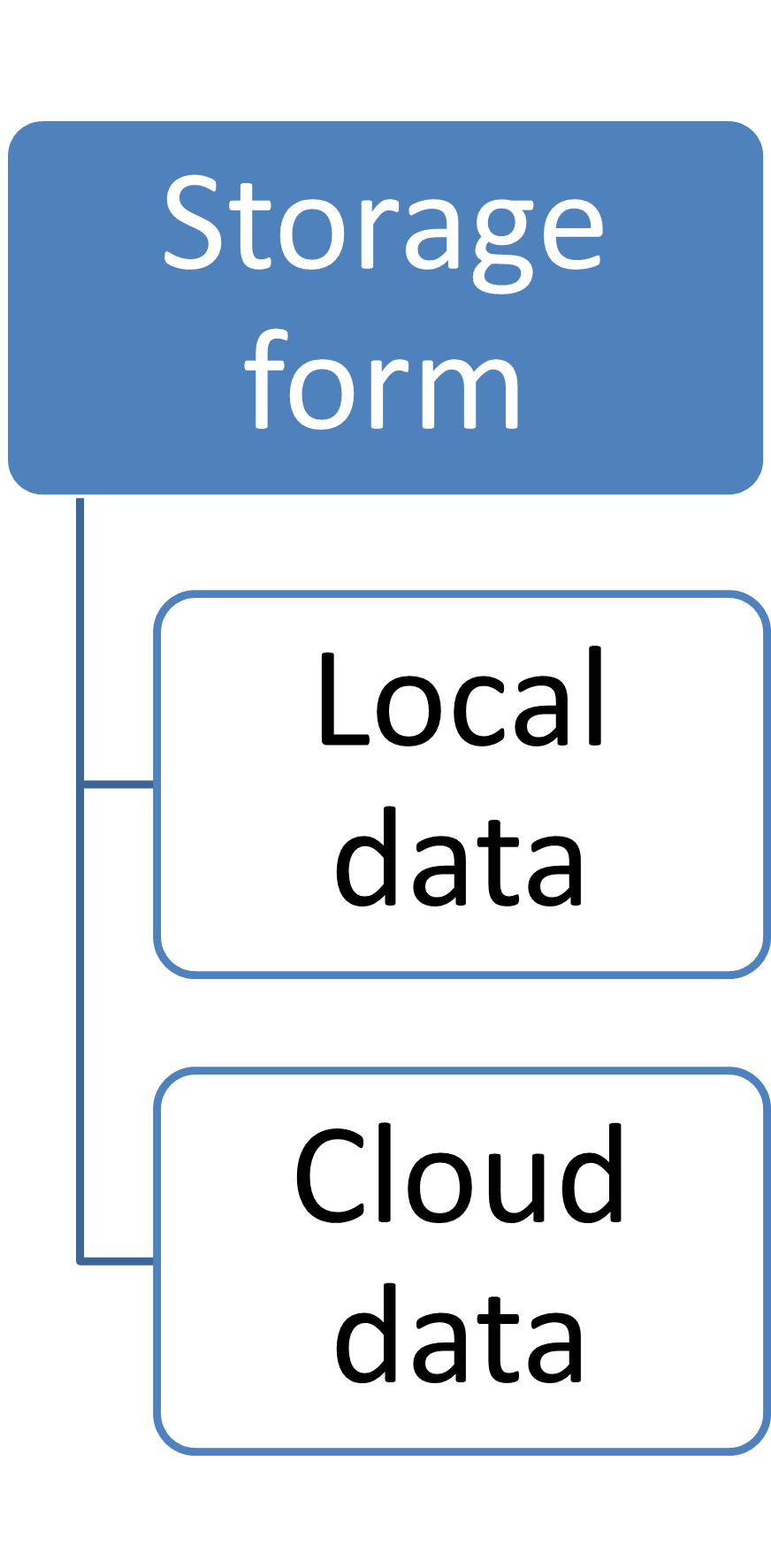 |
Local data
Cloud data
|
<<< back to 2.0
continue to 2.2 >>>
Chapter 2 Part 2 Data types
Part 2: Data types
A data type is a classification that specifies what kind of data a variable or object can store. Data types determine the possible values that a variable can assume and the operations that can be performed on these values.
In other words:
- Numbers can be integers or decimal numbers and mathematical operations can be applied to them.
- Characters can be strung together to form words, for example.
Examples of data types are:
- Integers: Store integers, e.g. 1, 2, 3.
- Floating point numbers (float): Store decimal numbers, e.g. 3.14, 2.718.
- Character strings (String): Save text, e.g. "Hello", "World".
- Boolean values (Boolean): Store truth values, e.g. true or false.
Elementary data types, also known as simple data types or primitive data types, can only accept one value from the corresponding value range.
Complex data types
Complex data types are data types that are composed of simpler data types. They make it possible to store and process structured data. Complex data types can combine several values and different types of data in a single unit. They are therefore also referred to as data structures.
Examples of data types
| Elementary data types | Complex data types |
| Whole numbers | Arrays |
| Are an extension of the natural numbers by negative numbers: ..., -3, -2, -1, 0, 1, 2, 3, ... | A collection of elements of the same data type that are addressed via indices. |
| Fixed point numbers | Structures |
| Numbers that have a fixed number of digits before and after the decimal point | A collection of fields that can contain different data types. |
| Enumeration types | Classes |
| Are variables with a finite set of values, e.g. color with the values: blue, green, red, yellow) | Similar to structures, but with additional functions such as inheritance and methods. |
| Boolean | Lists |
| Used to represent logical truth values: true or false | An organized collection of elements that can grow and shrink dynamically. |
| Character | Dictonaries |
| Are basic elements of a language, e.g. A, B, C, .... | A collection of key-value pairs where each key is unique. |
| Pointer | |
| Pointers are references to any other data type, e.g. the address of another data element |
Data structures
Data structures are used in almost all areas of computer science and software development. They help to organize and process data efficiently, which can significantly improve the performance of programs. For example:
- Search algorithms use trees and hash tables to enable fast search operations.
- Sorting algorithms use arrays and linked lists to arrange data in a specific order.
- Graphs are used to model networks and solve problems such as shortest path finding.
- Stacks and queues are essential for managing tasks and controlling the program flow.
<<< back to 2.1
continue to 2.3 >>>
Chapter 2 Part 3 Data formats
Part 3: Data formats
Data format - File format
Data format
Describes the structure and organization of the data, regardless of how it is stored or transmitted. It determines how the data is to be interpreted.
Examples:
- JSON: A text-based data structure for data exchange.
- CSV: Table structure with values separated by commas.
- XML: Hierarchical structure with tags to describe data.
Properties:
- Can be used both in files and directly in data transfer protocols.
-
Independent of the physical storage location of the data.
File format
Describes how data is stored in a file and specifies the programs or systems with which this file can be opened or processed.
Examples:
- .docx: File format for Microsoft Word documents.
- .jpg: Format for image files.
- .mp4: File format for video.
Properties:
- Identified by the file extension (e.g. .txt, .pdf) or by specific header information within the file.
- Focuses on the storage of data on a storage medium.
Data format and data processing
Within data processing, the term data format defines how data is structured and displayed and how it is to be interpreted during processing.
Examples:
- Characters and digits
- Figures in a wide variety of formats
- Logical statements (true or false)
For data fields:
- The length of the data field,
- the number of decimal places,
- the type of presentation,
- which values a field can assume,
- and other specific information.
Data format and data processing
Digit as a number: 1 has a numerical value. It is the smallest natural number and the basis for many mathematical operations. For example: 1+1=2.
Digit as a character: In texts and documents, the 1 can be used as a character to represent information without having a numerical value. For example, in a telephone number: "09913615199" or password: abs1xr!y
Numbers and their representation in computer systems
Number systems have developed historically. Roman numeral writing, for example, is an addition system.
The decimal system, a place value system in which 10 digits are assigned a value via their position within a number, is now common worldwide. The individual digits are defined by 100, 101, 102, 103, … or 1, 10, 100, 1000, ... digits.
In the computer world, the dual or binary system is mainly used. Here, only 2 digits (0 and ) are used, resulting in the place values 20, 21, 22, 23, 24, … or 1, 2, 4, 8, 16, ... .
For reasons of simplification, the octal (0-7) or hexadecimal (0-F) system is also used in some cases.
The binary number 01011 therefore corresponds to a decimal value of 11 (1+2+0+8+0=11)
The dual system in computer technology is based on the principle of circuits that can be off (0) or on (1).
Working with dual values
-
Decimal system
1011 = 1*103+0*102+1*101+1*100 = 1000+0+10+1 = 1011 -
Dual system
1011 = 1*23+0*22+1*21+1*20 = Dezimal: 9 -
What is 123 decimal in dual system

Characters and their representation in computer systems
- Like numbers, characters in computer systems are also represented in dual form. The ASCII or EBDI code is used for this.
-
Classification as a character or word (STRING) means that the corresponding dual code is not interpreted as a number but as a character.

<<< back to 2.2
continue to 2.4 >>>
Chapter 2 Part 4 Data management - File system
Part 4: Data management - File system
Sectors
Boot sector
- The boot sector contains information about the partition and
- Block size, (size of the storage units, files are distributed across many clusters in order to use the storage space effectively)
- Volume size (total size of the partition)
- Position of the Master File Table (MFT)
- Starts the boot loader of the operating system if the partition is bootable.
- The boot loader is a program that is responsible for starting the operating system (in this case Windows).
File information sector
- Saves Metadata of the stored files like:
- Name, Permissions, Owner/Group, Time Stamps, …
- Contains the addresses of the memory blocks (clusters) in which the data of the files are stored.
- Blocks allow the effective storage of files on storage media
- Blocks can be directly and indirectly adressed
- This allows the storage ob big files
- The maximum size of files depends on the size of the memory blocks
Data sector (file area)
- The data sector is divided into blocks.
- Contains the data of all files and directories.
- The smallest unit with which NTFS stores data.
- A block has a fixed size (typically 4 KB). Large files are distributed across several clusters.
- A file always occupies at least one block.
<<< back to 2.3
continue to 2.5 >>>
Chapter 2 Part 5 Data management - Databases
Part 5: Data management - Databases
<<< back to 2.4
continue to 2.6 >>>
Chapter 2 Part 6 The data processing process
Part 6: The data processing process
Data processing
Data processing refers to the systematic handling of data in order to record, store, organize, analyse, manipulate or display it. The aim of data processing is to obtain information from the raw data to support decisions or control processes.
Characteristics of data processing (EVA principle)
Algorithm
An algorithm is a finite sequence of clearly defined instructions or rules that are used to solve a specific problem or perform a calculation. Algorithms are widely used in mathematics and computer science and serve as specifications for performing calculations and data processing
Properties of an algorithm
- Finiteness: An algorithm must end after a finite number of steps.
- Unambiguity: Each step of an algorithm must be clearly and unambiguously defined.
- Inputs: An algorithm can have zero or more inputs.
- Outputs: An algorithm provides at least one output.
- Executability: The individual steps of an algorithm must be so simple that they can be executed in finite time
Examples of algorithms
- Examples of algorithms:
- Everyday life: A recipe for a cake is an algorithm: it describes the ingredients (input), the preparation steps (process) and the finished cake (output).
- Computer science: A search algorithm searches a sorted list for a specific element.
- Mathematics: The Euclidean algorithm finds the greatest common divisor (GGT) of two numbers.
- Algorithms are the basis of many modern technologies and applications. They are used in a wide variety of areas, such as
- Automation of processes.
- Optimization of resources.
- Data processing and analysis.
- Decision-making in artificial intelligence.
- Algorithms decide e.g. in social media and other applications such as YouTube, Facebook, Google, etc. which entries or advertisements are displayed to us and thus significantly determine our consumption and information behavior, which friends we have and thus influence our whole life.
Example of a simple algorithm - Bubble Sort
- A simple example of an algorithm is the Bubble Sort. Here is a step-by-step description of how this algorithm works:
- Input: A list of unsorted numbers.
- Compare: Compare the first element with the second element.
- Swap: If the first element is larger than the second, swap them.
- Move on: Go to the next pair of elements and repeat the comparison and swap.
- End of the list: When the end of the list is reached, start again at the beginning of the list.
-
Repeat: Repeat steps 2 to 5 until no more swaps are necessary.

Programming languages
- Algorithms are the basis for computer programs
- Computer programs are written in programming languages
- A programming language is a formal language that is used to develop software that can run on hardware
- Examples of programming languages are: Machine languages, Basic, C++, Java, PHP, Ruby, Perl, ...
<<< back to 2.5
continue to 2.7 >>>
Chapter 2 Part 7 Knowledge management
Part 7: Knowledge management
